“Often an evolution is a revolution without appearing to be one.
Thought from Pierre-Henri Cami is a good illustration of what is currently happening with voice assistants. You may wonder why I go so far as to speak of revolution.It is important to know that in addition to their rapid adoption, voice assistants are revolutionizing the interaction of humans with the digital world.

Search, content, advertising and commerce in general are impacted industry-wide as people transform the way they interact with brands through voice technology.
Is SEO in particular being/will be impacted by this technology?
In short, the answer is clearly “Yes”, and it has already started.
Note that results from voice search are sometimes unique. In other words, it is a small part of the content of a website that is used to offer an answer to a given request.
This implies that all other websites do not benefit from any visibility!
And you probably know what happens when a business loses visibility on the web: A risk of a sudden drop in activity.

It is becoming more and more undeniable for companies to prepare and adapt accordingly to the voice assistant revolution.

That’s why I’ve put together this guide, which aims to show you the reasons why voice assistants are very important and the different SEO strategies you can adopt to ensure that your content is optimized for voice search.
Chapter 1. What is a voice assistant and how does it work?
Before discussing voice search itself, I think it is very important to define precisely what a voice assistant is and how it works.
Thus, you will discover in this section, the possibilities offered by this technology in order to easily anticipate the reasons for its massive adoption.
1.1. What is a voice assistant?
A voice assistant is a digital program that uses voice recognition, natural language processing, and text-to-speech to assist users through voice recognition apps.
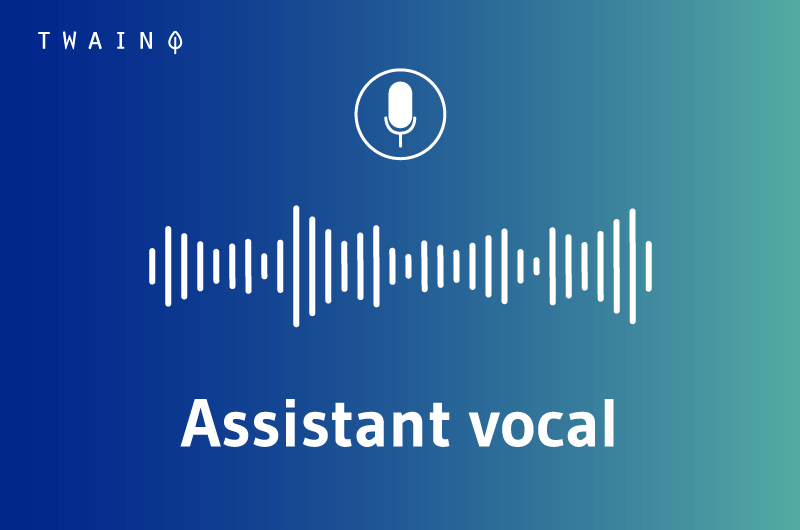
These computer programs are generally designed based on artificial intelligence (AI). Note that I had the opportunity to develop the concept of AIs in my guide to Google’s RankBrain which is also a machine learning machine.
You just have to understand that these AI programs try to guess users’ needs based on the data they collect.
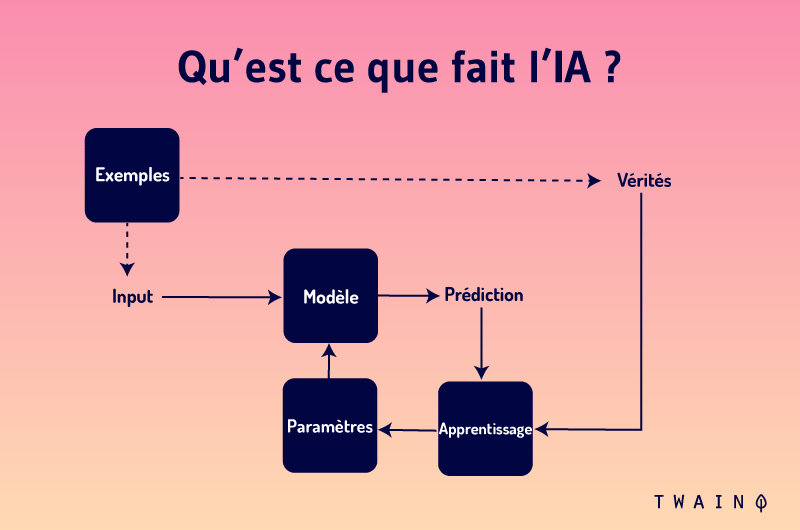
In this sense, they continue to improve constantly as long as they have a way to get feedback on the results they offer.
However, some voice assistants have a much more sophisticated system than AI: Cognitive computing or cognitive computing.
It is a technology that allows a digital assistant to understand and execute multi-step requests with many interactions.
It involves performing complex tasks such as booking a room in a hotel.
SearchEntrepriseAI sums up the difference between the two technologies well with this infographic:
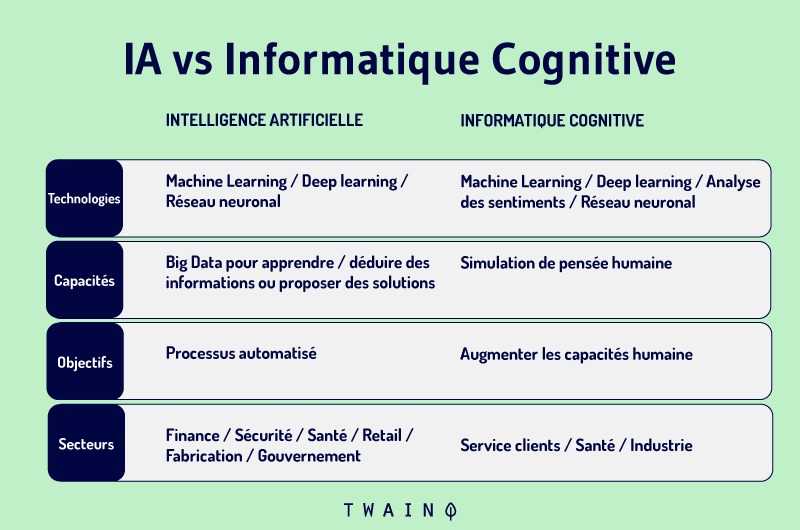
To put it simply, artificial intelligence relies on algorithms to solve a problem or identify hidden patterns in the data.
Cognitive computing, on the other hand, aims to create algorithms that mimic the reasoning process of the human brain. Which allows him to solve a series of problems as the data and problems change.
You now have an idea of what a voice assistant is and if you are as curious as I am, it would be interesting to know their history.
1.2. How have voice assistants evolved over time?
Contrary to what one might think, the beginnings of voice recognition and voice assistants date back to the 20th century.
Specifically, it starts with IBM introducing the first speech recognition tool in 1961: IBM Shoebox.

Obviously, it was still very primitive insofar as it could only recognize 16 words and numbers. Very limited, isn’t it?
After this first invention, voice recognition and voice assistants improved and became what we know today.
Here is an illustration from Voicebot.ai that shows the evolution of voice revolution over time:

Here is a brief history of the voice revolution and you can already see how much different brands are competing for the market.
In this regard, the two major brand names that are competing for the market are:
- Amazon;
- Google.

However, there is an increase in the market share of Google and other smart speaker brands.
Now let’s see what this technology can do for you.
1.3. How can a voice assistant help you?
Whether on your laptop or on another digital device, these digital assistants have access to a large amount of information.
Which allows them to perform tasks such as:
- Play music;
- Listen to an audiobook;
- Make reservations;
- Report a sports score;
- Share weather forecast;
- Adding items to a shopping list;
- Add events;
- Perform mathematical calculations;
- Ask for information, in the same way as for a search query;
- Etc.
Of course, the list is more or less long depending on the system you use.
Indeed, there are different products on the market, the most popular of which are:
- Siri for Apple;
- Alexa for Amazon;
- Google Assistant;
- Cortana from Microsofts.
The performances of each of them are remarkable and here are their characteristics according to the supports :
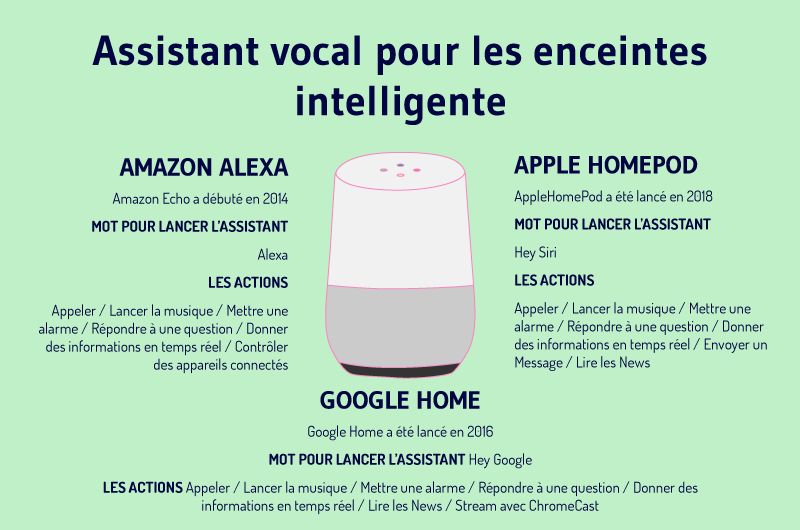
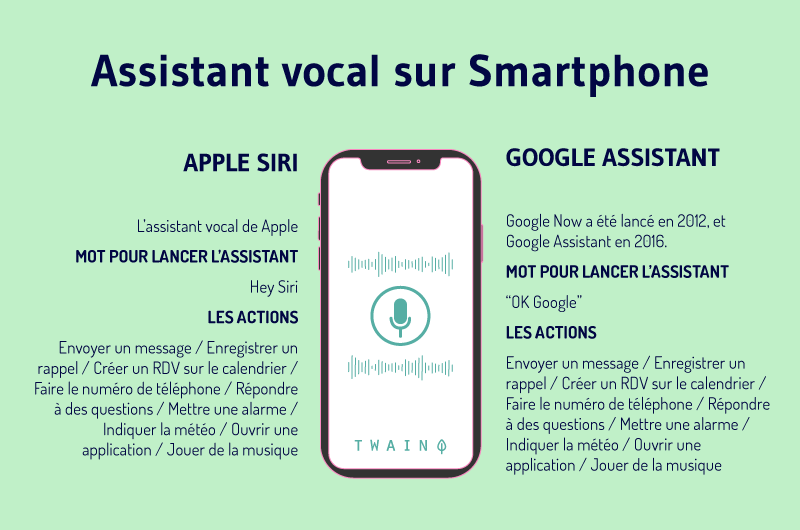
Cortana of Microsoft presents almost the same functionalities, but is found mainly on its products:
- Windows 10;
- Windows Phone;
- Xbox One;
- Etc.
You now know the tasks that a voice assistant can help you accomplish. Let’s take a quick look at how this kind of tool can interact with you.
1.4. How do voice assistants work?
Voice assistants or smart speakers are always listening for a word or an expression that activates them: Wake words or wake words.
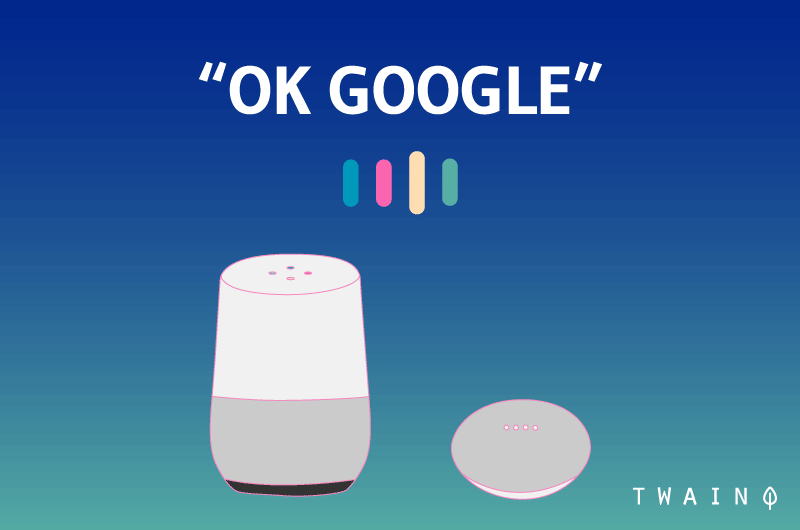
By default, the words “Hey Siri”, “OK Google”, “Hey Google” and “Alexa” are standard on the respective devices from Apple, Google and Amazon.
Indeed, if you pronounce these words or expressions, the devices will leave standby mode and will expect the following words to constitute a request to be processed.
However, users can customize their wake word to some degree.
For example, “Hey Google” can become “Alexa”, “Alice” or even “Smart”.
The ability to make these adjustments can be particularly useful if someone with the same name as the assistant is present in the house.
Imagine that you acquired Amazon’s assistant, Alexa in your home. But at the same time, your daughter or a loved one living in the house is also called Alexa.
Pronouncing this first name can become really annoying
In short, it must be noted that the algorithm of digital assistants is always listening for the wake word so that a phone, a smart speaker, or something else begins to communicate with a server to make its work.
That being said, what is the process followed by a voice assistant from the moment of receiving the request until the completion of a task?
website Gov.uk has designed this infographic:

To put it simply, the user’s voice message is converted using technology that transforms it speech in text or in a machine-readable structure.
The results are then passed to a dialogue manager/dialog manager which determines the best response to the user’s query.
To do this, the dialogue manager will take into account:
- The perceived intention of the user;
- Contextual elements such as device location.
This allows him to make the decision to perform such or such an action such as playing music continuously via a given application.
Once an appropriate response has been determined, the voice response heard by the user is produced. This is followed by the effective execution of the task or the user’s request.
This is a simple diagram of the interaction between voice assistants / intelligent personal assistants and users.
Nevertheless, it is important to note that this technology has certain limitations that are useful to highlight.
1.5. What are the limitations of voice assistants?
In voice search, users ask questions without context that are sometimes impossible to answer.
For example, Googler Amit Singhal had the opportunity to explain in an interview how users could ask questions such as: “Does my hair look bad?” »
Voice assistants will certainly have difficulty understanding and providing relevant results for this type of request.
You just have to understand that current digital assistant technology still has this kind of limitation. But let’s be visionary and assume that in the near future it will be possible.
There you go, now you know about smart personal assistants and it’s time to see why you should pay attention to this technology.
Chapter 2. Why should you consider voice assistants?
There are many reasons why you should consider voice assistants. Thus, I devote this chapter to statistics and data that are likely to not leave you indifferent.
2.1. What is the level of adoption of voice assistants?
What better way than to start with the level of adoption of this technology in order to get an idea of its evolution? Nothing !
2.1.1. The evolutionary trend of digital assistant adoption
To start, I used Google Trend , choosing a five-year period and the two most popular products:
- Alexa;
- Google Home.
Peaks are nothing but end-of-year periods when consumers typically purchase the most items. In particular with the aggressive advertisements of the signs.
That said, there is an overall positive development that shows that more and more people are interested in voice assistants.
Rest assured, these are not the only elements that lead me to advise you to take this technology into account.😊
2.1.2. Which countries have the highest adoption levels of voice assistants?
Voicebot.ai has published a blog post in which he indicates that the first phase of the adoption of intelligent personal assistants has already been completed and that we are in the second phase:

Indeed, Voicebot.ai was based on the traditional technology diffusion model where the early market accounts for the top 16% of product adoption.
A threshold already exceeded by the United States with more than 20% adoption, which makes it the country where there is majority adoption:

This analysis allows us to find relevant all the studies that have been carried out on voice assistants in the United States. Indeed, most of the studies on the subject come from the country.
2.1.3. How many people have adopted voice assistants?
In 2018, Voicebot carried out a study allowing it to observe that nearly 20% of the adult population uses a smart speaker at home:

In January 2019, i.e. in the space of a year, there was an increase of almost 40% according to another Voicebot:

With a sharp study, Leiner Perkins shows the dazzling evolution of voice search from 2008 to 2016:

This number will grow more and more to the extent that 50% of searches will be based on voice and image by 2020:
With these statistics, there is no longer any doubt that voice search is becoming increasingly important and must be able to adapt to the trend.
This finding leads Jeff McMahon, CEO of Voiefy to say, “The continued upward trend in adoption can no longer be overlooked by brands. The importance of effort and investment by Amazon and Google is supported by user adoption and purchase. Smart speakers are quickly becoming a dominant tool in everyday life.»
2.2. Who uses voice assistants?
If you are curious enough like me, here we will find out what kind of people are interested in voice assistants.
Ava Mutchler of Voicebot.ai discusses the adoption of smart speakers in these terms:
“It is growing faster than web and mobile, and adoption is faster. I think people are more open to new technologies than they were before. It does not seem foreign to us to speak to something. Voice is a very convenient way to communicate, especially with technology. Adoption is quite remarkable across all age groups.”
Speaking of age, it’s interesting to know that even seniors seem to want to accommodate this trend.
For the little anecdote, here is a video of an 85-year-old Italian woman who was trying to interact with “Google Home” which she calls “Goo Goo”:
Obviously, the video made the buzz on the web with more than 4 million views.
But let’s stop with the anecdotes and come to the statistics.
2.2.1. Between men and women, who uses smart personal assistants the most?
According to the Voicebot report in 2018, It seems that men are the most users of voice assistants:

Unfortunately, the reasons for this fact are not known☹
2.2.1. Which age group uses digital assistants the most?
In 2014, Google revealed that more than half of young people use voice search daily:

Although it is the youngest who have a high adoption rate, PwC found in 2018 that it is adults aged 25 to 49 who use these digital assistants the most:

Source: Pwc
In 2017, Pew Research Center takes its survey a little further and shows that almost half of adults in the United States use a voice assistant. Which is obviously close to Google’s observation.
The firm goes so far as to show the various electronic media used by these adults:
Which brings us to the following question:
2.2. What is the most used electronic medium?
Mobile devices are the most used for voice search especially since 20% of all searches on mobiles are voice:

It is important to note that this statistic comes from Google, but dates from 2016.
In 2018, the PwC revealed that the use of smartphones for voice assistance is 57%:

But although it is possible to use smartphones everywhere, they are less used at home compared to the home voice assistant :

As you can see, smartphones are the most used electronic media since they offer greater mobility. But once at home, mobiles are less used as voice assistants.
If so, let’s find out where these digital home assistants are used the most.
2.3. Where are voice assistants most used in a home?
If you’re wondering where smart speakers are often placed, this infographic from Voicebot gives you the answer:
So it seems that the living room is the main place where smart speakers are usually placed.
The kitchens as well as the bedrooms are not unworthy since they record high rates of use.
2.4. How often are digital assistants used?
In its study, Voicebot goes further and determines the number of uses of voice assistants:

From these statistics, it can be concluded that the frequency of use of smart speakers is 62% daily. While monthly, the rate is around 86%.
Let’s not stop there and find out what users are actually doing with their digital assistant.
2.5. What are users doing with their voice assistant?
The Voicebot allows us to determine what smart speaker users do with their tool as well as the frequency with which they perform these tasks:

It should be noted that at the bottom, there are approximately 12% of users who use already their assistant on a monthly basis to make purchases.
Regarding the use of intelligent personal assistants to make purchases, the PwC provides us with additional information:

In the space of one month:
- 58% of consumers use voice assistants to add items to their basket;
- 50% of consumers order or buy items.
You can see how this new technology is starting to influence the habits and behavior of Internet users.
However, it is important to note that these purchases are mainly for simple products that do not necessarily need special attention:

As you can see in this graph, there are a large number of users considering the use of voice assistants to make purchases.
Note: You may be wondering why I go to the effort of providing so much data. In fact, obviously I’m trying to show you the reasons why you should consider digital assistants in your marketing strategies, but not only.
These numbers can help you make informed decisions based on your target audience.
For example, you know that adults between the ages of 25 and 49 make heavy use of voice assistants. You also know the types of items people are likely to buy with their voice assistant.
This information allows you to increase your efforts in optimizing certain content for voice search, if necessary.
That said, it must be recognized that this technology is not unanimous.
2.6. Why is the adoption of voice assistants facing obstacles?
It is important to note that the system is not yet perfect:

There are still tasks that are not properly performed by voice assistants especially with smartphones.
On the other hand, most of those who do not use voice assistants are simply not interestedIn in this technology:

In addition, the question of privacy seems very important for some consumers:

Indeed, here is the comment of one respondent in the PwC study:
“If I want to try a new brand of coffee and an ad appears on [my social media account], that’s fine. I was looking for it on the internet anyway. But if the voice assistant listens to the daily conversations I have with the people in my life and then uses what’s said to recommend things, that’s weird to me and I think that’s beyond the limits of technology..
Despite these sticking points for the evolution of digital assistants, their future is already guaranteed
2.7. What does the future hold for voice assistants?
2.7.1. Digital assistants will know a lot more adoption
Geomarketing allows us to see that 65% of Amazon echo or Google Home owners can no longer imagine their life without their voice control system.
Indeed, those who use this new technology seem satisfied with their experience:

This observation is confirmed by a Tractica which predicts that the number of unique users of virtual assistants will increase from 390 million in 2015 to 1.8 billion worldwide by the end of 2021.
Additionally, the number of unique businesses using voice assistants will increase from 155 million in 2015 to 843 million in 2021.
The firm’s principal analyst, Mark Beccue, says,
“Meanwhile, most of the global tech giants believe that VDAs [Virtual Digital Assistant] will be vital for their businesses in the future, and they are investing significant resources to capture market share at this early stage.
Indeed, companies seem to invest in voice assistants, but much less than individuals:

Also, study cited above, shows that 9.8% of those who do not have a smart speaker think theadopted in 2018.

By 2024, Mane.co.uk forecasts that the market share of this technology will increase at an annual rate of almost 35% between 2016 and 2024.
We can thus expect a significant number of Internet users using intelligent personal assistants.
At this level, you already have an idea of the magnitude of this revolution that is already upon us. Now, I will ask you to see a little further in a few years.
2.7.2. Features/capabilities of voice assistants will evolve
Adoption of digital assistants will be higher, but that’s not what I want to draw your attention to in this section.
Indeed, technology is constantly evolving and there is no doubt that the tasks that these AIs will allow us to perform will become more important and more complex.
Mary Meeker describes the evolution of voice recognition well in her annual report on the internet:
Moreover, it should not be forgotten that voice recognition itself has evolved a lot until there:

Better, they themselves are able to self-improve since their system is based on Artificial Intelligence.
Smartsheet says,
“The voice assistant could get so smart that it will automatically order pizza if you say you’re hungry. It will use existing data from your previous purchases to come to the conclusion that saying you are hungry is like ordering a pizza.
If have a restaurant, you would want to be the restaurant that the digital assistant chooses as the place to order the pizzas. We will come back to the SEO part in the following chapters.
Theatlantic.com adds,
“A subfield of artificial intelligence called computational creativity forges algorithms that can write music, paint portraits, and tell jokes. The results so far have not threatened to put artists out of work, but these systems can increase the human imagination. »
Let’s not stop at these two futuristic claims that depict what the future holds with voice assistants.
Consider the opinion of Ava Mutchler, co-founder of Voicebot.ai:
“I think they [voice assistants] will be everywhere, and the smart speaker could disappear in a few years because many technologies, like televisions and refrigerators, will have their own voice assistant. Today’s children will not understand that there was a world where you couldn’t talk about things”.
The idea here is to show you where we’re headed when it comes to voice assistants. Although a revolution needs a few years to become general, it is obvious that it is more than ever time to prepare.
Of course, this is only if you want your content to be the ones that will be used by voice assistants to offer answers to their users.
Chapter 3. What is the impact of voice assistants on search engines?
In the previous chapter, you would have noticed that Internet users use voice assistants mainly to carry out searches on search engines:

Voice search is actually one of the many tasks that assistants can perform digital.
We can then define voice search as referring to the use of a smartphone, computer or any electronic device that has a voice assistant to perform searches.
However, it is much more of a dialogue process as the system may occasionally ask additional questions for clarification.
At this level, it is quite legitimate to ask why voice assistants are popular for research.
3.1. Why is voice search so popular?
There are three fundamental factors behind the mass adoption of voice search.
3.1.1. Voice search requires less effort
As one can easily guess, voice search avoids having to use the keyboard to type a query that seems tedious.
And this is exactly the observation made by Stone Temple when he asks Internet users the reasons why they use voice commands:

Source: Backlinko
Writing a request letter by letter can be tedious compared to the voice search that can be done with minimal effort.
For example, a search for “how to plant fruits and vegetables in paris” takes more time and requires more concentration in writing than in speaking.
3.1.2. Voice search is much faster
Voice search is much faster than typing and statistics indicate that this speed is more than 3.7 times :

Source: Backlinko
By minutes, you can see that the volume of words is significantly higher with the voice search.
By analogy, this speed may enable Internet users to quickly obtain the information they need.
3.1.3. Searching is more convenient with mobile when it is voiced
The third reason is the fact that voice search seems very well suited to search on mobiles.
Indeed, Stone Temple shows that 58% of mobile phone users use voice search:
The different reasons for using voice search are relevant and they are enough to increase the adoption of this feature.
But before we see the strategies you can use to adapt to this trend, let’s look at how search habits.
3.2. How is voice search changing the way people search?
3.2.1. Queries are longer and more conversational
Voice search has changed the way people search in two different ways:
- Queries have become longer;
- Searches have become more conversational.
Indeed, Bing carried out a study which allowed him to notice that voice queries generally contain more words than written queries:
The most interesting thing is that voice queries are much more conversational.
For example, a written query might look like this:
“Backlink definition”.
While a voice request can be of the type: “what is a backlink? »

Imagine you are talking to your friend and you want to know what a backlink is. Which of the two queries are you going to use?
Obviously, you’re not going to go up to your friend and just say “backlink definition”, but rather ask “what is a backlink?” “.
Google confirmed this fact by showing that 70% of searches performed on Google Assistant are in natural language:
As you can guess, this approach to finding information necessarily has an impact on the approach used to conduct keyword research.
We will have the opportunity to dissect this aspect in chapter 4.
3.2.2. Voice search changes location-based search
Survey Stone Temple, Internet users are very comfortable using their voice assistant to make a voice request even in public places:

This shows how convenient this way of performing queries is, no matter where you are.
For example, consider the fact that searching for the type query “…. Near Me” has exploded in recent years.
Indeed, Google reveals that from 2015 to 2017, the “near me” type query increased by more than 500%:

During the same period of time, the “….near me” type query now” has increased by 150%:

Thus, we can estimate that a good part of Internet users using the voice request could carry out the request of the type “…near me” in their search.
How would that be possible? Let’s use a simple example to understand.
You are with your child and you walk around Paris without determining in advance the restaurant where you will have your lunch.
For your choice, you will not just take the nearest restaurant, you will need a restaurant with a good reputation. Even if the closest one is excellent, we like to let the search engines give us confirmation like 70% of buyers do.
Although the text query will have fewer words, picking up your phone and starting to type your query will require a lot more attention. In addition, you risk losing sight of your child for a few moments.
Whereas with voice search you just have to use your voice and the voice assistant will take care of giving you the best restaurant you are likely to go to.
Is this how it usually happens? It would seem so insofar as the majority of Internet users who have carried out a geolocated search visit or call during the day:
This is a good illustration of how voice search impacts geolocated search.
3.2.3. Voice Search Is Changing How Internet Users Receive Results
In an article, Skift.com shows that Google is becoming an answer engine for travellers:
“Google has been in the search engine business since the dawn of the internet and it’s now getting closer to actually answering travelers’ search questions rather than providing a list of relevant and irrelevant links.concept
Does not only apply to travellers.
When we analyze the evolution of Google from the Knowledge Graph to the featured snippet, we see that the search engine tries to provide the most relevant answers without its users having to perform other actions.
On this subject, the click rate in the SERPs has decreased by almost 37% in the space of 2 years:

The reason is very simple, you no longer have to click anything in order to have an answer to your query:
Guess what? Google is following the same approach with voice search.
Take a look at the image above, I used the text query to get the result I wanted.
Suppose I didn’t have a featured snippet, I would have had to search the different URLs that Google will offer me.

But with voice search, Google is able to give precise answers in seconds:

When you use Google’s application, you are also entitled to SERPs. But the search engine tries to give you a unique result by reading the result present in the featured snippet.

“According to Culturegenerale, the largest country in the world: Russia. With its 17,098,242 km² spread over two continents, Europe and Asia, Russia is the largest country in the world. Its surface area corresponds to approximately 11% of the land surface.“
Under these conditions, what strategy should be adopted?
Chapter 4: How to do SEO in the world of voice search?
I I certainly don’t need to show you the existing relationship between search engines and SEO. But you agree with me that if the way of carrying out searches and getting results changes at the level of Internet users, it is essential to review SEO strategies

Voice search is considered a real revolution in the sphere of SEO since it changes the way Internet users interact with search engines
. From your computer, tablet, or laptop, you’ll typically see:
- 1-3 ads at the top;
- 10 organic search results.
But if you do a voice search, sometimes you will only get one result.
Indeed, if you perform a voice search on a screen device, you may be lucky enough to see a few additional results.
But if this is done via a Smart Speaker, Smart Watch or in the car via Apple CarPlay or Android Auto, you must be in the first position to have visibility.
So, even without reaching the first place in the classic SERPs, you benefit from a good visibility with a considerable amount of traffic. But with voice search, being in 2nd or 3rd position does not allow you to have visibility.
So how do you increase your chances of ranking #1for voice search?
4.1. How do you research keywords in the world of voice search?
Keyword research is a very important step in optimizing content on the web.
With voice search, it remains no less crucial and could become much more important than before.
The following steps will let you know what to do.
4.1.1. Get to know your audience well to simulate their conversations
The success of keyword research always depends on the level of knowledge you have of your target audience. This is even more accentuated with voice search.
In the following section, you will have the opportunity to see that content in the form of questions / answers are preferred for voice search.
Now, if you don’t know your audience well enough, how can you determine exactly what questions they might have? And this, in order to provide elements of response to their needs.
Admittedly, it will be very difficult to accomplish such a feat.
That’s why I recommend that you design a buyer persona or if you already have it, update it if you haven’t already.
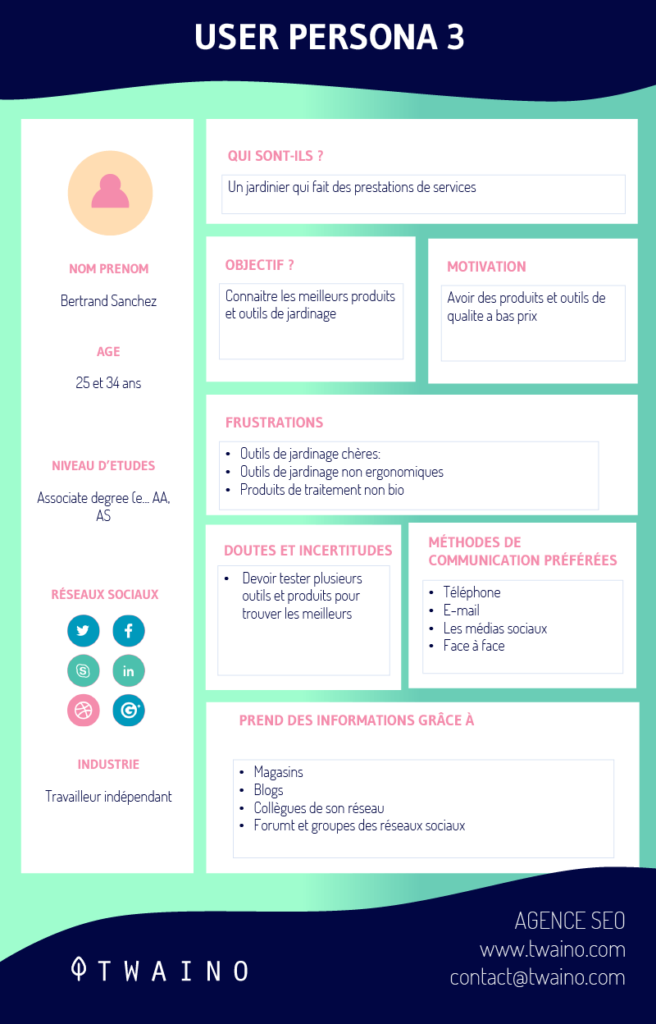
Note that:
“Personas are fictional characters typically used in user-centric marketing strategies. These people are created to represent the different types of ideal customers for your business or website. »

If you don’t know concretely what it is and how to create it, consult my article on the semantic cocoon.
In addition to being able to create buyer personas, you will have the opportunity to discover how to create content adapted to their needs and how to create effective internal networking.
On this, I recommend that you take useful sources of information such as:
- Discussion forums;
- Your customer service data;
- Data from your CRM or emails.
These are usually the sources that allow you to get a clear idea of your target audience’s concerns.
Plus, use audience demographics from Google Analytics to get an overview of who your visitors are, then analyze them by affinity groups and interests.
Go further and also consider:
- Conducting interviews with your audience;
- Hold panel discussions;
- Conduct opinion polls with your audience and also collect questions / answers.
Use this data to identify typical pain points and the solutions they seek.
More importantly, pay attention to the language they use to list their problem.
This already allows you to have words and expressions that you can integrate into your content optimized for voice search.
4.1.2. Promote natural language keywords
When doing keyword research, it’s important to keep in mind that voice search relies much more on natural and conversational language.
Let’s say you are doing a keyword search on “shoes”.
You use for example Ubersuggest, to get ideas for keywords:

Usually, you will base yourself on elements such as:
- The search volume;
- The value per click;
- SEO or SEA difficulty;
- Etc…
But with voice search, there is the “natural language” or “conversational” factor that is added.
As voice search adoption scales, natural-sounding keywords will receive a surge in search volume.
It is for this reason that you will prefer a keyword such as “women’s walking shoes” than “women’s walking shoes”.
The first keyword will allow you to perform better in the SERPs for voice search than the second.
Keep in mind that mechanical-sounding keywords will perform less and less with voice search.
Also remember that the only way to optimize content for RankBrain which is Google’s AI is to use a natural tone.
4.1.3. Adopt natural keywords even if they seem long
Long-tail keywords do not have a high search volume. It is for this reason that they are often left to the detriment of classic keywords.
As we have seen, queries have become relatively longer with voice search:

Source: Backlinko
For this reason, you can be reassured about using keywords with more than 5 words .
That said, it’s not about optimizing your pages only with such keywords.
The idea is to scatter them all over your content since Google is able to find them no matter where they are in the content.

This is a concept that we will take the time to develop a little further. Keep in mind, however, that Google is able to respond to voice queries regardless of where the content is located.
4.1.4. Prioritize query keywords
In their article on the impact of voice search on the search market, Searchenginewatch conducted a study to determine how often query keywords appeared in queries.
These are keywords such as:
- Who: Who;
- How: How;
- When: When;
- Where: Where;
- Why: Why;
- What: What.
They found that there’s a 61% growth in these phrases year over year:

As you can see, queries containing the “who” question are the most popular.
According to the site, this would have a direct relationship with voice search and the Knowledge Graph.
If you noticed, we need to use query queries less with classic search than we do with voice search.
For example, suppose you want to know the name of Barack Obama’s wife.
For a typical query, you’ll probably use a query like “barack obama wife”:
That said, you’re likely not going to use this query when you go to voice search.
It wouldn’t be convenient to use your voice and say to Google “woman barack obama”.
Rather, you will ask a question in the form:

“Who is Barack Obama’s wife”.
So how do you find such keywords to optimize content?
4.1.5. How to find relevant keywords for voice search?
The best option for finding keywords that answer your audience’s questions is to use SEO tools.
Tool 1: Answer the Public
Answer the Public is a powerful tool for finding great keywords and topics to talk about:
It’s pretty easy to use, but consider taking out a subscription if you want to take advantage of the full potential of the tool.
Although I will dedicate another article to its use, here is in a nutshell how you can enjoy the tool for free.
You will select the language in which you wish to have your answers:
Once you click on “Get Questions”, you have the following page:
You have five kinds of results:
- Questions;
- Suggested topics;
- Comparisons;
- The alphabetical which includes the different variations of the term;
- Relative terms.
For the “sports shoe” theme, I have 50 questions that the audience could ask themselves:
The same goes for the proposals:
In terms of comparison, I have the following elements:
The relative terms are as follows:
As far as the alphabetical is concerned, I have the following proposals:
The tool also offers you the option of importing all the response elements in CSV for manual analysis or integration into certain tools:
Or even downloading the data in the form image:
With this tool, you can easily find a multitude of keywords that can help you optimize your content for voice search.
We are not going to stop there!
Tool 2: BuzzSumo Question Analyzer
There is also BuzzSumo Question Analyzer which is very useful for finding questions that Internet users are asking on a particular topic:
To learn how to use this feature, you can consult the BuzzSumo which includes a lot of details that I cannot give you at the moment.
But I find it interesting to address the subject in its entirety another time.
With these two tools, you will have the possibility to find all the keywords you need to optimize your content for voice search.
4.2. How to optimize content for voice search?
You already have your keywords, and it’s time to get down to business steps you can take to optimize your content for voice search.
4.2.1. Use short, concise answers in your content
Brian Dean did a study on voice search and found that Google tends to give short answers that are around 29 words in length:

For example, when I do the research “what is artificial intelligence? I have a 23-word answer:
“Artificial intelligence set of theories and techniques developing complex computer programs capable of simulating certain traits of human intelligence (reasoning, learning, etc.).performing

(If we can have something like that (the bottom image), that would be cool) When
voice search optimizations, it’s useful to keep this factor in mind. Thus, your content can be used to provide answers to user queries.
With this in mind, you can recommend certain types of content that are ideal for voice search.
4.2.2. Create types of content that adapt to voice search
The forms of content that are most suited to voice search are:
- FAQs or Frequently Asked Questions;
- Practical guides.
The reason these contents are great for voice search is because voice queries are usually in the form of questions.
Indeed, after the term “who” whose answers will probably be short and will come from the Knowledge Graph, there is “how”.
As you know “How” is the most used term for in FAQs or guides.

Also, remember that Google tends to give an average of 30 words for the answers it offers to its users.
There is no doubt that these two important criteria are easily fulfilled with an FAQ page.
Through his study, Brian Dean found that the answers offered for voice search come almost twice as much from the FAQs:

He gave this example:
To be honest, I tried about ten questions, but I couldn’t get a concrete example of an answer from an FAQ.
On the other hand, most of the answers I have had come from guides. For example, when I make the request “how to choose the right shoe”, Google offers me an article in the form of a guide:
Same type of content offered for the question “when can I go boar hunting” :
For a while you have noticed that most of the queries that I had the opportunity to use as examples are featured snippets. There is a reason for this !
4.2.3. Optimize your content for the featured snippet
According to Brian Dean’s study, 40.7% of responses from voice search come from the featured snippet.

For example, when I make the request: “how to plant a tree?” Google give me this answer:
Indeed, Google only read the feautred snippet as an answer.
Being in the featured snippet is therefore a relevant objective for having visibility for voice search with Google Home and Alexa.
As a reminder, the featured snippet or zero position is the result that provides a short and precise answer to your question. It generally does not exceed 3 or 4 lines and offers a link to the source.

STAT conducted a study in which it was found that text represents 81.95% of all featured snippets. While lists represent 10.77% and tables are used in 7.28% of cases.
In addition to texts optimized for the featured snippet, you can consider bulleted lists to occupy position 0.
4.2.4. Write your content in a conversational and natural language
We have already covered this aspect of voice search, but let’s come back to a few points.
Indeed, the textual search seems more mechanical insofar as one concentrates on entering the most important words of a query.
Voice search is more conversational and usually there are no omitted words in queries.
It is for example: “how to choose the right shoe size?”‘s
say you’ve embedded this phrase into your content.
Either in the form of a subtitle or a question with the answer that directly follows having a length of 30 words.
Google will be able to detect the correspondence between your content and the request of the Internet user.
This would hardly have been the case if you had used a keyword such as “choose the right shoe size”.
4.2.5. Create long-form content and use long-tail keywords
Google no longer relies solely on keywords to deliver its results.
This also applies for voice search as less than 2% of all voice search results have the exact keywords in their title tag.

This simply means that Google does not necessarily rely on the presence of certain words in the title to offer its results.
The search engine is able to find the relevant answer to a query, even if it is a very small portion of the text.
Take this example, “Is having a garden good for your health?”me
, let’s see the content of the page:
As you can see, the search engine has drawn from different places the elements of the answer it offered me.
For this reason, it is relevant to produce authoritative content that will position itself on different voice search queries.
You now know the essential strategies to adopt to optimize your content for voice search. But as usual, I won’t stop there and I’ll give you lots of tips to use to adapt to voice search.
Chapter 5: 18 strategies and tips to rank better for voice requests
In this section, you will have a multitude of tips, each as interesting as the other. They are only an extension of the points I have covered so far!
Tip 1: Answer all questions briefly
It goes without saying that we want to answer all questions from our audience.
But this time around, it’s essential to not only identify the questions, but also to know the different ways in which they are asked by our audience.
How you answer these questions is very important.
Tip 2: Write easy-to-understand content
According to Brian’s study, the average voice search result is the equivalent of a 3rd grade reading in College Source

That is, the texts are written with simple words and expressions. This makes it easy to understand the content.
That’s why you should avoid using a lot of jargon-based terms.
If you want your content to be used to provide answers to voice queries, make it simple and easy to digest.
Tip 3: Voice queries can be longer, but answers should be short and concise
Voice queries are longer than text queries. But it’s important to be brief and target short, conversational sentences to optimize your content.
Make sure the sentences are short/concise and the answer is at the beginning of the page, paragraph or sentence.

Also, consider summarizing your content at the top of the page using a table of contents or a short bulleted list of key points.
Tip 4: Create an on-site customer support center or at least an FAQ section
This will allow you to answer many frequently asked questions from your audience.
In addition, thanks to an intelligent internal mesh, you can add clues to other pages of your website.

Source: Marketinganalytico
Adding a support center also has additional benefits from a customer relationship management perspective. Indeed, you will probably reduce customer service costs and you will also have fewer unhappy customers.
Tip 5: Co-create answers with audience members
Co-creating Q&A content with key members of your audience is a great option for optimizing your content’s SEO.
This is because your users will be less likely to come up with over-optimized or SEO-ready answers. They will probably write more naturally with the most appropriate terms.
Additionally, on the customer retention scale, co-creation with members of the public as partners in projects is considered one of the highest attainable levels.

Tip 6: Anticipate next questions or information needs
Ask yourself the following questions:
- What is your audience asking for next and how are they asking for it?
- What are the typical sequential questions that follow each other?
Think about the user’s tasks and the steps to accomplish those tasks when searching.
In this way, your content will be acclaimed because Google will consider that it is complete and will be able to fully satisfy the user.
Tip 7: Keep the context of your writing
With voice search, it is not very effective to use expressions such as:
- He/she is;
- They are;
- Etc.
Instead, refer to the named entity or person to avoid confusion. Try to keep the linguistic context as often as you can, unless it’s ridiculous.
Tip 8: Use filler words in your keywords
Now you know voice search queries are usually complete with no missing words.
It is for this reason that it is wise to use the complete keywords.

As Purna Virji Bing’s
“The more matches you have, the more likely your ad will show up on a voice search that includes words like ‘to’ and ‘me’ and ‘for’. ”
When optimizing your content for voice queries, be sure to include full keywords that sound natural and conversational.
Tip 9: Have impeccable text
Another very important point to keep in mind is to make sure you write the content in the language in which they are likely to speak and to pay attention to grammatical errors as well as pronunciation.
In voice search, the text seems to be pronounced exactly as it is written with spelling and grammar
Grammatical errors and spelling errors in texts written on web pages can therefore be a real handicap when you want your content to be optimized for voice search.
Tip 10: Anticipate next questions with suggested queries
An analysis of queries in search results gives us solid clues as to what comes next from typical users.
Google usually has sections to show other types of questions from its users. Which allows you to sniff out what people are really looking for and then provide relevant answers.
This is the ‘Other questions asked’ section:
It also has ‘Related searches’:
Tip 11: Secure your website with the SSL certificate
HTTPS websites dominate Google’s voice search results.
In fact, Backlinko’s study shows that 70.4% of Google Home results pages are secured with the HTTPS protocol:

Curious to know that Moz tracks the most important SERP features and ranking factors in its MozCast.
At the time of writing, HTTPS accounted for 96.4%:
Source: Moz
Indeed, Moz tracks the SERP for 10,000 keywords every night and of all sites ranking for those 10,000 keywords , 96.4% are HTTPS in the top 10 results.
Since this is not just about classic SERPs or voice search, it is important to note that the security of websites with the SSL certificate is very important.
Do not hesitate to consult my guide on Https in order to secure your website.
Tip 12: The number of shares on social networks is important
Content with a high level of social engagement tends to perform well in voice search according to Brian’s study.
Indeed, the average result of a voice search is 1,199 Facebook actions and 44 Tweets:

At this level, it is important to note that Google does not use social shares to classify content:
Indeed, the firm uses social sharing to improve content exploration or crawlability.
Also, there is no doubt that most content that receives high volumes of backlinks also tends to receive high volumes of social shares.
And it is precisely the backlinks from other websites that allow pages to rank in the SERPs.
Finally, simply note that the more your content gets visibility and shares, the better its chances of being considered the perfect answer to certain queries.
Tip 13: Be in the top 3 for your topics
Content that ranks high in traditional search is also highly likely to appear as a voice search response.
Brian shows that around 75% of voice search results rank in the top 3 for this query.
Although there will be a continued increase in the number of voice queries, traditional desktop search remains important. Google will continue to rely on its primary ranking factors to determine which results are relevant to voice search.
So it’s always relevant to continue to optimize your website as you already do to occupy the top positions of the SERPs.
Tip 14: Optimize the loading speed of your website
Loading speed is one of Google :
This is also confirmed at the level of voice search since Google offers its voice results in 0.54s.
This exceeds the average loading speed of websites by 3.8 times:

To keep pace with this speed, it is important to ensure that your website loads very quickly.
Tip 15: Improve the authority of your website
The correlation between theauthority of websites and their position in the SERPs is high:
The same goes for voice search since the average authority of the domains used by Google to display its results is close to 77:

This is obviously a fairly high figure, but don’t worry! Google may use content from websites with lower authority where it deems it relevant.
This is my previous example “how to choose the right shoe?” :
Website Authority is 43:
That said, Page Authority doesn’t seem to be a very important ranking factor for voice search.

The correlation is quite low according to this study, but what is certain is that Google takes into account the authority of the website.
This is because most voice search results are just one result.
Thus, Google needs to know that it offers an answer from a trusted source. That is, information from a website that inspires a lot of trust and authority.
However, keep in mind that domain authority has more weight than web page authority. Thus, a new article can be considered for voice search if Google deems it relevant.
To do this, focus your efforts on optimizing the authority of your website, in particular through the creation of backlinks.
Tip 16: Adopt long-form content
There is a strong correlation between the length of content and the ranking of results on Google:

Indeed, the average length of content on the first page of Google is 1,900 words
According to the study According to Brian, the average length of content for voice search is longer and is 2,312 words:

However, this does not necessarily mean that for voice search, Google puts more emphasis on long content.
It should be understood that a page with rich and long content is more likely to “match” several voice queries.

So even if Internet users use other terms with the intention of having the same information, Google will be able to offer your content.
Tip 17: Optimize your videos for the “video featured snippet”
For several years, Google has been emphasizing videos for certain queries.
However, this content format was not presented in the featured snippet until recently:
Source: HubSpot
HubSpot conducted a study on this type of result in 2018 and indicates that:
- The name of a video is very important ;
- Up-to-date video is very important;
- The ranking of the video in YouTube is not very important;
- The length of the video was not important;
- A textual and detailed description is very important.
What’s most interesting is that Google manages to jump right to the part that seems most relevant to your question:
Brian says these kinds of results tend to show up for queries with a natural tone:
“And from my testing informal (and Bing data), these types of video results tend to show up more often for natural language queries.(The type of natural language queries that people use in voice searches)”
To illustrate this part, I’m going to use Brian’s example which is particularly difficult to replicate.
Indeed, let’s consider that you want to rank your videos in YouTube and that you perform the request “YouTube SEO”.
Source: Backlinko
For this query, there are videos as results, but they occupy the fifth position of the SERPs:
Source: Backlinko
However, when you go for a more conversational or natural query, the ranking changes.
It considers the query “how do I rank my YouTube videos” and here are the results:
As you can see, you get a featured snippet video.
Obviously, this is the kind of query a user will make with voice search.
This makes it important to also think about optimizing your videos for voice search.
Tip 18: Optimize for the query “….near me” or “near me”
Voice search has evolved with Google’s ability to determine the search intent of its users.
A few years ago, you were obliged to specify the place or the city in which you are in order to have geolocated results.
Now things are different and you can query like: “restaurant nearby” and get relevant answers:
If you have a local establishment, you should also think about optimizing by including terms used for voice search.
For example, if your restaurant is near the Eiffel Tower, you will optimize your content for the keyword “restaurant near the Eiffel Tower”.
Thus, when a Google user is at the Eiffel Tower and searches for “restaurant nearby”, he will be able to see Google My Business .
It is important to note that nearly half of searches on Google have a local setting:
Additionally, it should be noted that local searches on mobile often result in a purchase:
Mobile intent is very different from desktop and this must be taken into account.
Realize that mobile phone voice searches are likely to be performed much more locally than on home devices like smart speakers.
Understanding which queries are typical for which type of device, in which scenario, and what your audience’s consumption preferences are is important.
The way you formulate the pages will have to be adapted to these different devices and to the behavior of the user.
Consumers will say different things at different times on different types of devices and in different scenarios.
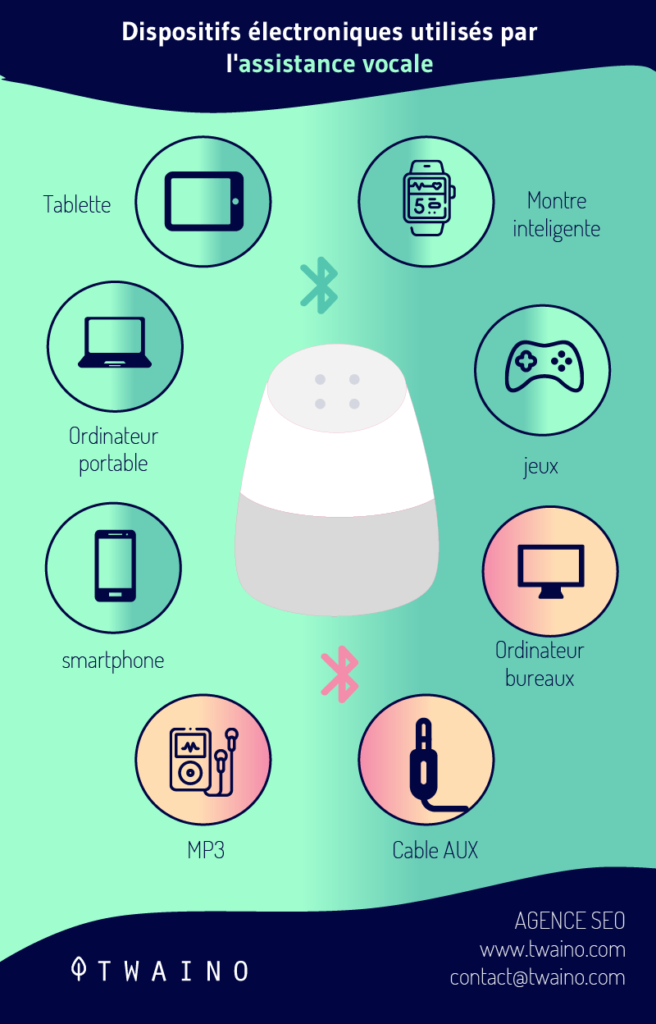
Users always want to be able to consume information in different ways and we know there are different learning styles:
- Visual;
- Verbal;
- Physical ;
- Auditory;
- Logic ;
- Social ;
- Lonely.
We each have our preferences or partial preferences with a mix of styles depending on the scenarios or even our mood at the time.
So be sure to optimize your content by considering all the possibilities through Google My Business and Google Maps for your local visibility.
And there you have it, we are at the end of the various tips that I have found to share with you.
But I can’t leave you without giving you some real-life voice search case studies.
Chapter 6: 2 case studies of voice search
You now have an idea of what to do to optimize your content for voice search.
But it’s always helpful to see how other people have managed to get their content to come up for this type of search.
Until then, I admit that I have not had the opportunity to concretely optimize my content for voice search.
So I don’t have a personal and detailed case study to show you. That said, I will rely on the case studies presented by Brian Dean in his article on voice search.
The idea is to allow you to actually see what has been done and the results achieved.
Case Study 1: Backlinko’s Guide to Building YouTube Channels
Brian published a guide to YouTube marketing that he optimized for voice search:
To make his article perform well for voice search, he inserted FAQ in the different parts of its guide.
Which seems to have worked since the answer given by Google regarding the query “What is a YouTube channel description?” is taken from their article:
Source: Backlinko
L excerpt from his post:
Now let’s talk about a few factors that could have caused his content to be considered in voice search.
6.1.1. The presence of a frequently asked questions section
In his guide, Brian has taken care to answer basic questions that everyone could ask themselves.

Source: Backlinko
This involves mentioning the question and providing a short, concise answer, ideally within the 30-word margin.
6.1.2. The presence of the content in the featured snippet
For the same query, the content in question is used to give a direct answer in the featured snippet:
Source: Backlinko
As you can see, the answer is clear and concise since the translation gives this:
“A channel description (also known as an “About Page”) is a brief overview of the type of content you post on your channel. It appears on your channels page and in YouTube search results.In
English, this definition is 35 words long, which is not too much of an ideal word count.
6.1.3. The level of understanding of the text
Having read its content on the description of a YouTube channel, I confirm that the level of reading is relatively low.
You don’t need to be an expert in YouTube marketing to understand his guide, and even beginners can get by easily.
6.1.4. Backlinko Domain Authority
An analysis of Backlinko.com’s Domain Authority on Ahrefs reveals that the Domain Rating is 85, which is well above the average of 77.

On the other hand, the Page Authority is very low since it is 12.

It seems that the authority of the pages is not very important for voice search.
That said, let’s take another example still from Brian Dean that seems a bit more complete.
Case Study 2: Backlinko’s Guide to Google Keyword Planner
Brian has also optimized his guide to using Google’s Keyword Planner for voice search.
Its content is offered as an answer to the voice request “How to access the Google Keyword Planner?” (How do you access the Google Keyword Planner)

Source: Backlinko
It is important to note that after its content, there are the pages of Google explaining how to use Keyword Planner:

Google itself has a Domain Rating of 99 and it would not be wrong to think that these Google pages have a very large number of backlinks.
It would have been normal if the search engine used its contents to provide results, which is not the case.
Backlinko’s authority is 85, which is much lower than Google’s. And as he explains, the two elements that allowed him to achieve such a feat are the language and the format of his content.
Indeed, the guide is written in such a way that a novice can understand exactly how to use the tool.
Additionally, its guide is 2,497 words in total, which is pretty close to the average length of the first voice search results.
Conclusion. Voice search: A revolution that does not speak its name
“Before a revolution happens, it is perceived as impossible; after that, it is considered inevitable.
This quote from Rosa Luxemburg lends itself perfectly to what is currently happening with voice assistants.
Indeed, their adoption is accelerating more and more and those who use them do not intend to part with them anymore.
Thus, it is undeniable that this technology has come to take hold and could become the main means of interaction of Internet users with the digital world.
In the SEO sector, there is a chance that the impact will be much greater than expected.
As we have the opportunity to see, most voice search results are unique. In other words, only one result is provided for certain queries.
In this situation, it would be irrelevant to consider taking the second or third place. You will simply have no visibility!
This is why it is urgent for any SEO professional or online business to adopt, while there is still time, the necessary measures to accommodate this technology.
In my present guide, I have taken care to bring you the reasons why such urgency is justified.
I have also listed all the strategies and tips that I find relevant to follow this trend and properly optimize content.
Use them and don’t hesitate to share your performance with us.
As for me, I’ll keep you posted on my progress with practical cases, if Google ever takes my content into account to propose voice responses.
See you soon!



